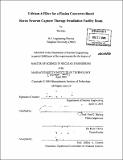Lithium-6 filter for a fission converter-based Boron Neutron Capture Therapy irradiation facility beam
Author(s)
Gao, Wei
DownloadFull printable version (4.849Mb)
Alternative title
Lithium-six filter for a fission converter-based BNCT irradiation facility beam
Other Contributors
Massachusetts Institute of Technology. Dept. of Nuclear Engineering.
Advisor
Otto K. Harling.
Terms of use
Metadata
Show full item recordAbstract
(cont.) A storage system was designed to contain the lithium-6 filter safely when it is not in use. A mixed field dosimetry method was used to measure the photon, thermal neutron and fast neutron dose. The measured advantage depth is 9.3 ± 0.1cm without filter and 9.9 ± 0.1cm with 8mm lithium-6 filter. The result is consistent with the result of Monte Carlo calculation. The design of a lithium-6 filter to be used in Boron Neutron Capture Therapy was developed. The lithium-6 filter increases the average energy of the epithermal neutrons in the epithermal neutron beam. This filter allows the beam to be used for effective BNCT treatment at greater depth in tissue. Based on Monte Carlo calculations, 8mm thick lithium-6 filter was found to be the optimum filter thickness for the MIT fission converter based epithermal neutron beam (FCB). The highly reactive lithium metal filter is sealed with aluminum covers against the humidity and surrounding air. A well shielded and convenient frame was also designed to hold the lithium-6 filter. The frame is separated into two parts. The fixed part of the frame will be mounted into the patient collimator of the FCB and provides a slot for the lithium-6 filter. The filter itself will be connected to the movable part of the frame and slid in and out of the beam through a pair of roller bearing tracks like a vertical drawer. Both parts of the frame are built with borated polyethylene (RICORAD) and steel to insure good shielding. Many safety issues have been considered in the design including tritium production, nuclear heating, pressure from released gases and radiation leakage on the side of the collimator.
Description
Includes bibliographical references (p. 164-165). Thesis (S.M.)--Massachusetts Institute of Technology, Dept. of Nuclear Engineering, 2005.
Date issued
2005Department
Massachusetts Institute of Technology. Department of Nuclear Engineering; Massachusetts Institute of Technology. Department of Nuclear Science and EngineeringPublisher
Massachusetts Institute of Technology
Keywords
Nuclear Engineering.